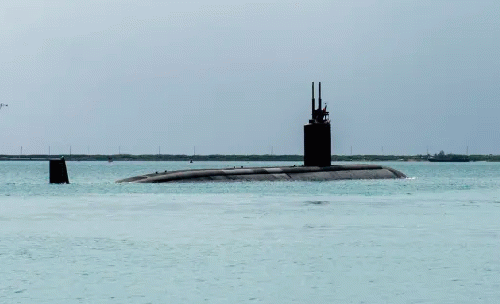Despite the Danger of COVID-19, the US Military Continues War Practice in Europe and Pacific and Plans for More in 2021
ANGLO AMERICA, 25 May 2020
Ann Wright | OpEd News - TRANSCEND Media Service
19 May 2020 – During the COVID-19 pandemic, not only will the U.S. military have the largest maritime military maneuvers in the world, with Rim of the Pacific (RIMPAC) coming to the waters off Hawaii August 17-31, 2020 bringing 26 nations, 25,000 military personnel, up to 50 ships and submarines and hundreds of aircraft in midst of a worldwide COVID-19 pandemic, but the U.S. Army is having a 6,000-person war game in June 2020 in Poland. The State of Hawaii has the most stringent measures to combat the spread of the COVID-19 virus, with a mandatory 14-day quarantine for all persons arriving in Hawaii — returning residents as well as visitors. This quarantine is required until at least June 30, 2020.
If these weren’t too many military operations during an epidemic in which personnel on 40 U.S. Navy ships have come down with the hyper-contagious COVID-19 and military personnel and their families have been told not to travel, plans are underway for a U.S. Army division-sized exercise in the Indo-Pacific region in less than a year — in 2021. Known as Defender 2021, the U.S. Army has requested $364 million to conduct the war exercises throughout Asian and Pacific countries.
The pivot to the Pacific, begun under the Obama administration, and now under the Trump administration, is reflected in a U.S. National Defense Strategy (NDS) that sees the world as “a great power competition rather than counter-terrorism and has formulated its strategy to confront China as a long-term, strategic competitor.”

The Los Angeles-class fast-attack submarine USS Alexandria (SSN 757) transits Apra Harbor as part of regularly scheduled operations in the Indo-Pacific on May 5, 2020.
(Image by (U.S. Navy/Mass Communication Specialist 3rd Class Randall W. Ramaswamy)) Details DMCA
This month, May 2020, the U.S. Navy in support of the Pentagon’s “free and open Indo-Pacific ” policy aimed at countering China’s expansionism in the South China Sea and as a show of force to counter ideas that the capabilities of U.S. Navy forces have been reduced by COVID-19, sent at least seven submarines, including all four Guam-based attack submarines, several Hawaii-based ships and the San Diego-based USS Alexandria to the Western Pacific in what the Pacific Fleet Submarine Force announced publicly that all of its forward-deployed subs were simultaneously conducting “contingency response operations.”
The U.S. military force structure in the Pacific will be changed to meet the National Defense Strategy’s perceived threat from China, beginning with the U.S. Marine Corps creating new infantry battalions that will be smaller to support naval expeditionary warfare and designed to support a fighting concept known as Expeditionary Advanced Base Operations. U.S. Marine forces will be decentralized and distributed across the Pacific on islands or floating barge bases. As the Marine Corps eliminates much of its traditional equipment and units, the Marines plan to invest in long-range precision fires, reconnaissance and unmanned systems, doubling the number of unmanned squadrons.
To effect this change in strategy, marine infantry battalions will go down to 21 from 24, artillery batteries will go to five down from 2, amphibious vehicle companies will be reduced from six four and F-35B and F-35C Lightning II fighter squadrons will have fewer aircraft per unit, from 16 aircraft down to 10. The Marine Corps will eliminate its law enforcement battalions, units that build bridges and reduce the service personnel by 12,000 in 10 years.
The Hawaii-based unit, called a Marine Littoral Regiment, is expected to have 1,800 to 2,000 Marines carved out mainly one of three infantry battalions based at Kaneohe Marine Base. Most of the companies and firing batteries that will make up a littoral anti-air battalion will come from units not currently stationed in Hawaii.
The III Marine Expeditionary Force, based in Okinawa, Japan, the main Marine unit in the Pacific region, will be changed to have three Marine littoral regiments that are trained and equipped to operate within contested maritime areas. The region will also have three Marine expeditionary units that are globally deployable. The other two Marine expeditionary force units will provide forces to the III MEF.
The U.S. military war games in Europe, Defender Europe 2020 is already underway with troops and equipment arriving at European ports and will cost about $340 million, which is roughly in line with what the U.S. Army is requesting in FY21 for the Pacific version of the Defender series of war maneuvers. Defender 2020 will be in Poland June 5-19 and will take place at Drawsko Pomorskie Training Area in northwestern Poland with a Polish airborne operation and a U.S.-Polish division-size river crossing.
More than 6,000 U.S. and Polish soldiers will participate in the exercise, named Allied Spirit. It was originally scheduled for May, and is linked with Defender-Europe 2020, the Army’s largest exercise in Europe in decades. Defender-Europe was largely canceled because of the pandemic.
U.S. Army Europe is planning additional exercises over the coming months focusing on training objectives originally outlined for Defender-Europe, including working with equipment from pre-positioned stocks in Europe and conducting airborne operations in the Balkans and Black Sea region.
In FY20, the Army will conduct a smaller version of Defender Pacific while Defender Europe will get more investment and focus. But then attention and dollars will swing over to the Pacific in FY21. Defender Europe will be scaled back in FY21. The Army is requesting just $150 million to conduct the exercise in Europe, according to the Army.
In the Pacific, the U.S. military has 85,000 troops permanently stationed in the Indo-Pacific region and is expanding its longstanding series of exercises called Pacific Pathways with extending the time Army units are in countries in Asia and the Pacific, including in the Philippines, Thailand, Malaysia, Indonesia and Brunei. A division headquarters and several brigades would have a South China Sea scenario where they will be around the South China Sea and the East China Sea over the course of a 30- to 45-day period.
In 2019, under the Pacific Pathways exercises, US Army units were in Thailand for three months and four months in the Philippines. The U.S. Army is discussing with the Indian government about expanding military exercises from roughly just a few hundred personnel up to 2,500 for a duration of up to six months which “gives us a presence in the region longer as well without being permanently there,” according to the US Army of the Pacific commanding general. Breaking from the larger exercise, smaller US Army units will deploy to countries such as Palau and Fiji to participate in exercises or other training events.
In May, 2020, the Australian government announced that a delayed six-month rotation of 2,500 US Marines to a military base in Australia’s northern city of Darwin will go ahead based on strict adherence to COVID-19 measures including a 14 day quarantine. The Marines had been scheduled to arrive in April but their arrival was postponed in March because of COVID-19. The remote Northern Territory, which had recorded just 30 COVID-19 cases, closed its borders to international and interstate visitors in March, and any arrivals must now undergo mandatory quarantine for 14 days. U.S. Marine deployments to Australia began in 2012 with 250 personnel and has grown to 2,500.
The Joint US Defense facility Pine Gap, the U.S. Department of Defense and CIA surveillance facility that pinpoints airstrikes around the world and targets nuclear weapons, among other military and intelligence tasks, was also adapting its policy and procedures to comply with Australian government COVID-19 restrictions.
As the U.S. military expands its presence in Asia and the Pacific, one place it will NOT be returning to is Wuhan, China. In October, 2019, the Pentagon sent 17 teams with more than 280 athletes and other staff members to the Military World Games in Wuhan, China. Over 100 nations sent a total of 10,000 military personnel to Wuhan in October, 2019. The presence of a large U.S. military contingent in Wuhan just months before the outbreak of the COVID-19 in Wuhan in December 2019, fueled a theory by some Chinese officials that the U.S. military was somehow involved in the outbreak which now has been used by the Trump administration and its allies in the Congress and the media that the Chinese deliberately used the virus to infect the world and adding justification for the U.S. military build-up in the Pacific region.
 Ann Wright is a 29-year US Army/Army Reserves veteran, a retired United States Army colonel and retired U.S. State Department official, known for her outspoken opposition to the Iraq War. She received the State Department Award for Heroism in 1997, after helping to evacuate several thousand people during the civil war in Sierra Leone. She is most noted for having been one of three State Department officials to publicly resign in direct protest of the 2003 Invasion of Iraq. Wright was also a passenger on the Challenger 1, which along with the Mavi Marmara, was part of the Gaza flotilla. She served in Nicaragua, Grenada, Somalia, Uzbekistan, Kyrgyzstan, Sierra Leone, Micronesia and Mongolia. In December, 2001 she was on the small team that reopened the US Embassy in Kabul, Afghanistan. She is the co-author of the book Dissent: Voices of Conscience. She has written frequently on rape in the military.
Ann Wright is a 29-year US Army/Army Reserves veteran, a retired United States Army colonel and retired U.S. State Department official, known for her outspoken opposition to the Iraq War. She received the State Department Award for Heroism in 1997, after helping to evacuate several thousand people during the civil war in Sierra Leone. She is most noted for having been one of three State Department officials to publicly resign in direct protest of the 2003 Invasion of Iraq. Wright was also a passenger on the Challenger 1, which along with the Mavi Marmara, was part of the Gaza flotilla. She served in Nicaragua, Grenada, Somalia, Uzbekistan, Kyrgyzstan, Sierra Leone, Micronesia and Mongolia. In December, 2001 she was on the small team that reopened the US Embassy in Kabul, Afghanistan. She is the co-author of the book Dissent: Voices of Conscience. She has written frequently on rape in the military.
Tags: Anglo America, Arms Industry, Arms Race, Conflict, Geopolitics, Hegemony, History, Human Rights, Imperialism, International Relations, Invasion, Military, Military Industrial Complex, Military Intervention, Military Supremacy, NATO, Occupation, Politics, Power, US Military, USA, Violence, War, West, World
DISCLAIMER: The statements, views and opinions expressed in pieces republished here are solely those of the authors and do not necessarily represent those of TMS. In accordance with title 17 U.S.C. section 107, this material is distributed without profit to those who have expressed a prior interest in receiving the included information for research and educational purposes. TMS has no affiliation whatsoever with the originator of this article nor is TMS endorsed or sponsored by the originator. “GO TO ORIGINAL” links are provided as a convenience to our readers and allow for verification of authenticity. However, as originating pages are often updated by their originating host sites, the versions posted may not match the versions our readers view when clicking the “GO TO ORIGINAL” links. This site contains copyrighted material the use of which has not always been specifically authorized by the copyright owner. We are making such material available in our efforts to advance understanding of environmental, political, human rights, economic, democracy, scientific, and social justice issues, etc. We believe this constitutes a ‘fair use’ of any such copyrighted material as provided for in section 107 of the US Copyright Law. In accordance with Title 17 U.S.C. Section 107, the material on this site is distributed without profit to those who have expressed a prior interest in receiving the included information for research and educational purposes. For more information go to: http://www.law.cornell.edu/uscode/17/107.shtml. If you wish to use copyrighted material from this site for purposes of your own that go beyond ‘fair use’, you must obtain permission from the copyright owner.

